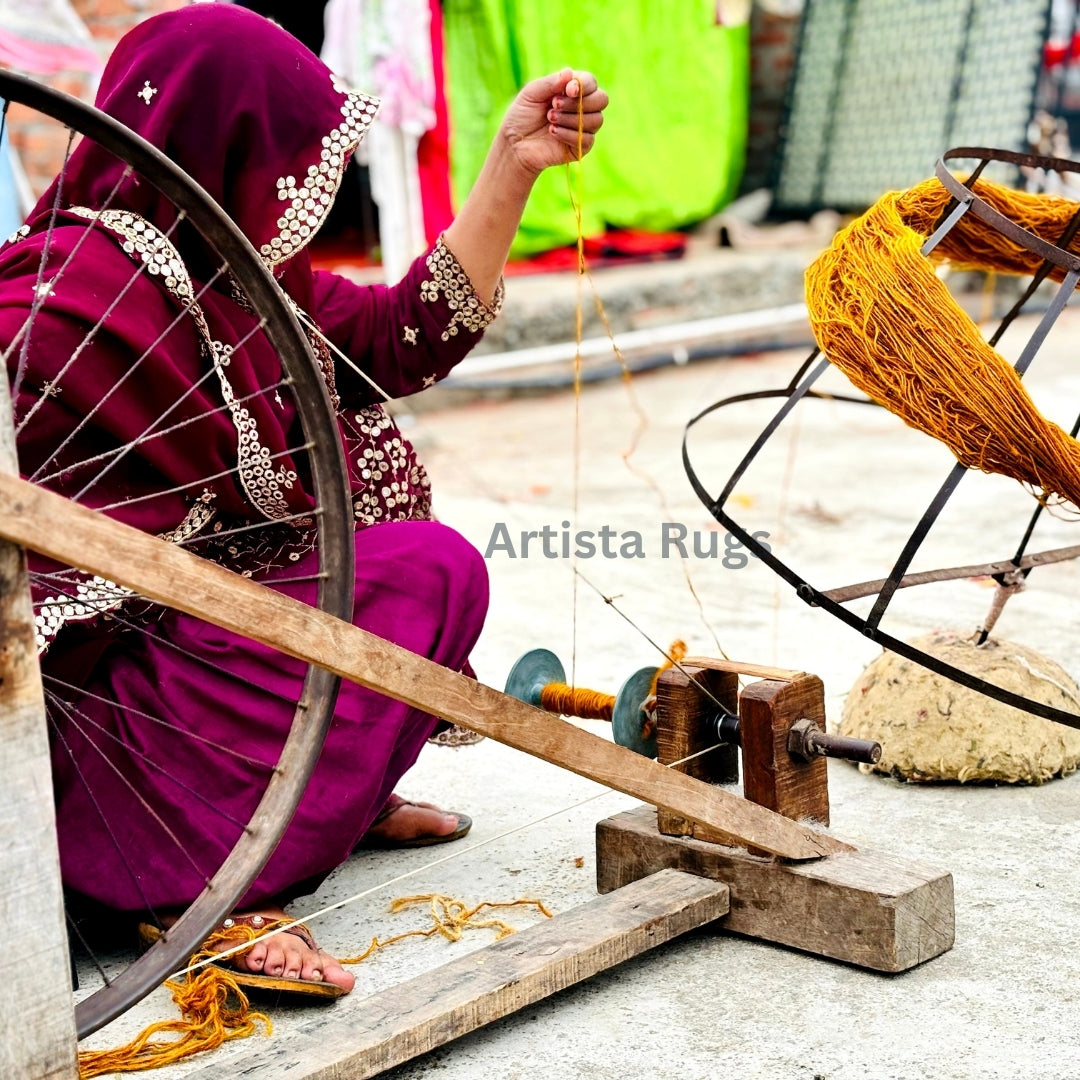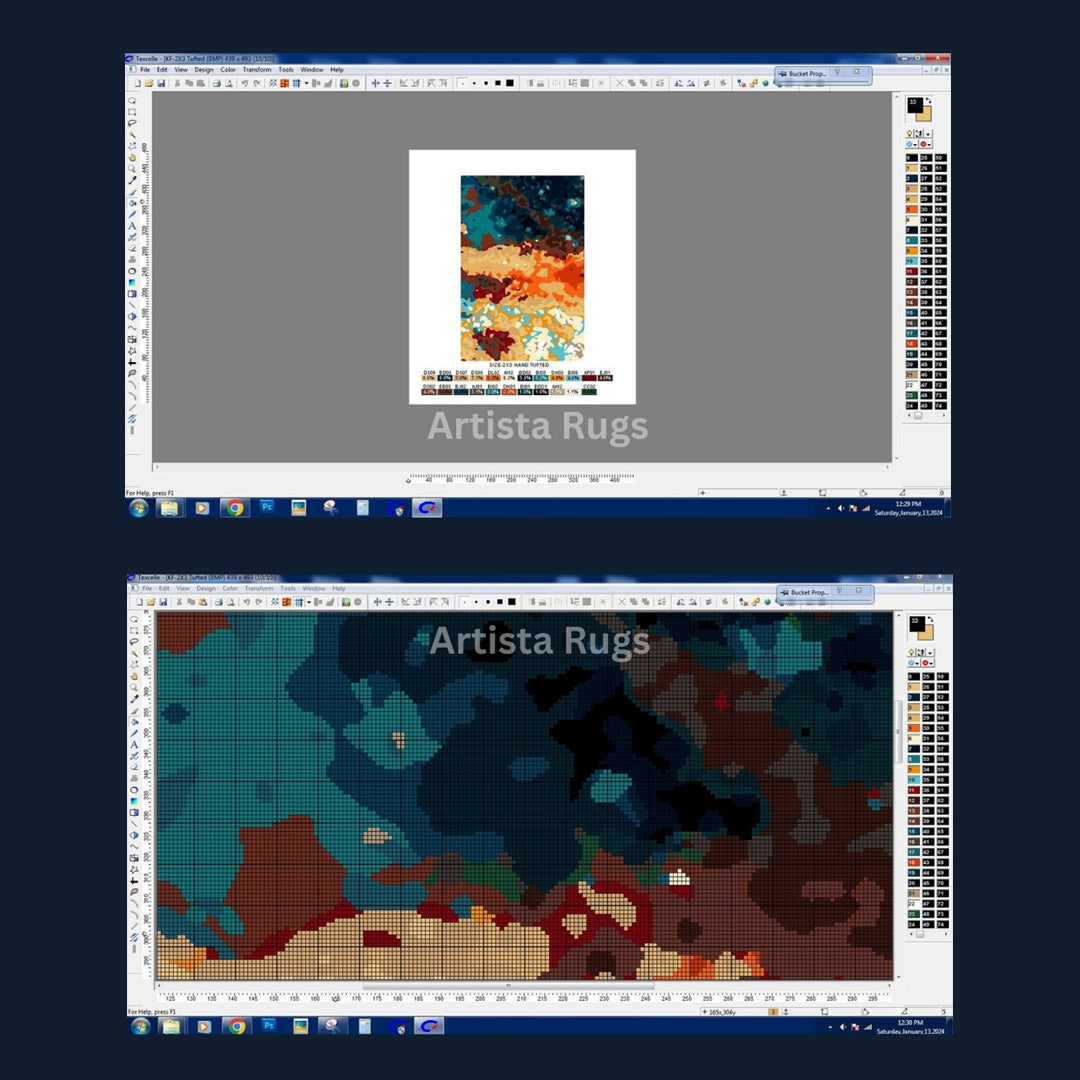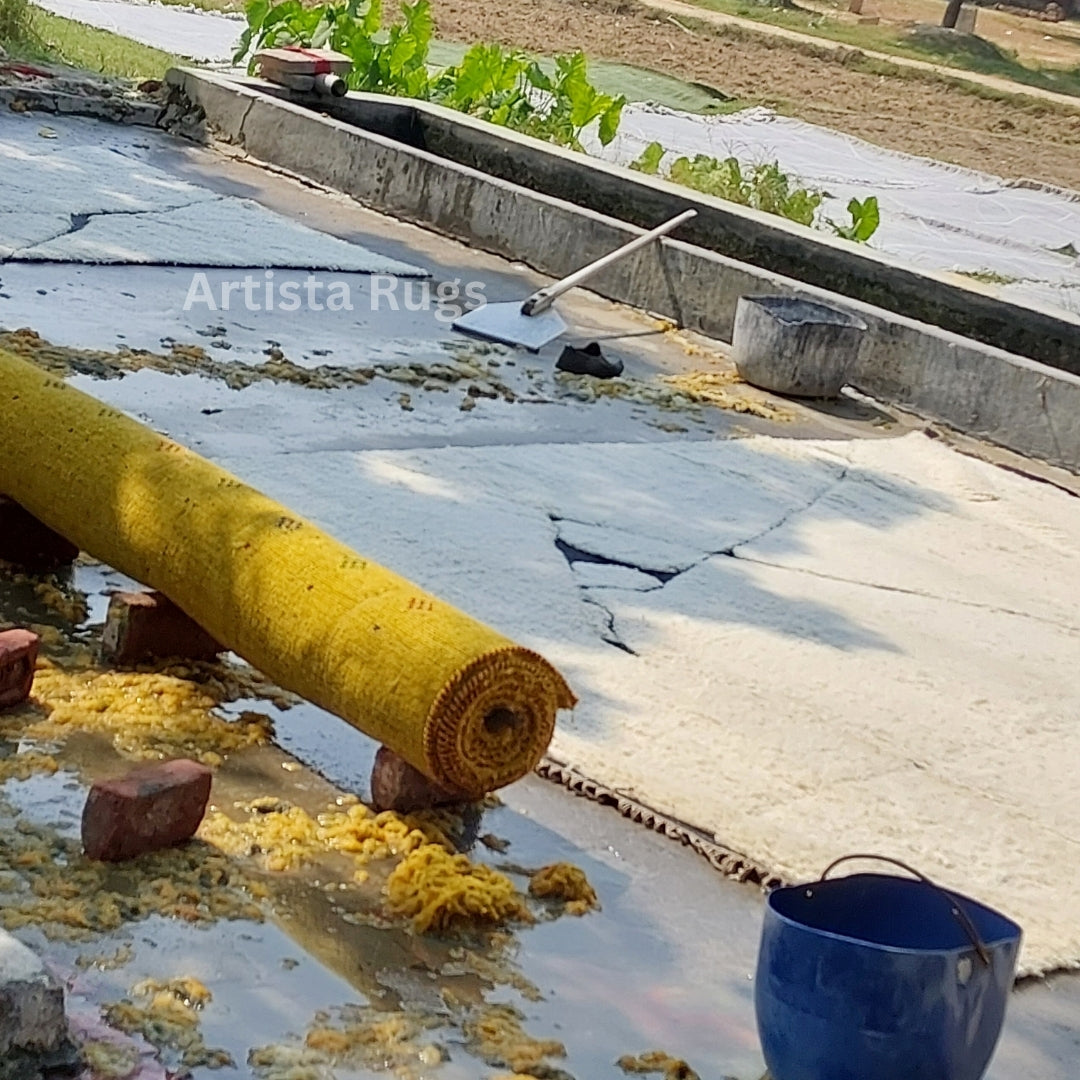Craftmanship
Creating a handmade rug involves various methods and materials. Different types of yarns offer distinct qualities such as strength, softness, and shine. Some feel smooth and cool, while others are luxuriously soft and warm. In addition to traditional materials like wool, silk, and cotton, we explore the benefits of diverse fibers like Viscose, Art Silk, Mohair, merino, and alpaca.
We prioritize natural materials, preserving their inherent characteristics carefully. Once a yarn is selected, there are numerous techniques for knotting, weaving, Tufting, twisting, and looping to craft a handmade rug. These techniques result in a range of textures, from fine and flat to chunky and shaggy. While the intricacies of weaving methods can be complex, here's a brief overview of the basics.
The journey of a Handmade rug
Choosing the right raw wool for handmade rugs is a crucial step in the rug-making process. Skilled artisans carefully select wool that meets specific criteria for quality and characteristics. They look for wool that is soft, strong, and resilient, as these qualities ensure durability and comfort in the finished rug. Additionally, the wool's natural color and texture are considered, as they influence the final appearance of the rug. Artisans may also assess factors such as fiber length and thickness to determine how well the wool will hold up to weaving and dyeing processes. By meticulously selecting the best raw wool, artisans can create high-quality handmade rugs that are both beautiful and long-lasting.

Step 2 - Spinning
Skilled Indian spinners transform carded wool or other fibers into yarn, a process vital in rug making. Their expertise allows them to craft yarn of different thicknesses, influencing the rug's knot counts. This mastery results in rugs of varying quality and texture.

Step 3 - Designing
Innovative rug-making merges traditional and contemporary styles with CAD tools. Our skilled design team prioritizes symmetry, proportion, and detail, shaping intricate digital designs. These serve as the foundation for handcrafted rugs, adding beauty and personality to spaces, where innovation and tradition converge to tell stories through artistic design.
Step 4 - Dyeing
Dyeing wool for handmade rugs involves coloring the wool fibers before they are woven into the rug. This process requires skill and precision to achieve desired colors and patterns. First, the wool is cleaned and prepared for dyeing. Then, it is immersed in a dye bath, where it absorbs the dye molecules. The wool may be submerged multiple times to achieve the desired shade. After dyeing, the wool is rinsed and dried before being used in the rug-making process. Experienced artisans carefully select and mix dyes to create unique and vibrant colors for their rugs, resulting in beautiful and distinctive handmade creations.
Step 5 - Balling
Winding the yarn into balls also serves practical purposes, such as preventing tangling and ensuring uniform tension during the weaving process. It streamlines the workflow and minimizes disruptions, allowing weavers to focus on their craft without interruptions.
Step 6 - Weaving
Weaving stands as a crucial stage in the production of hand-knotted, tufted rugs & other methods, representing a cornerstone of rug-making craftsmanship. Expert artisans meticulously interlace yarns on specialized looms, employing traditional techniques to create intricate patterns and textures. This process not only contributes to the rug's aesthetic appeal but also influences its durability and quality. By adjusting weaving techniques and densities, artisans achieve variations in texture, pile height, and knot counts, resulting in rugs of diverse characteristics. Each handwoven rug embodies the skill, precision, and artistic expression of its maker, reflecting a rich cultural heritage and dedication to craftsmanship.
Ultimately, weaving is not merely a technical process but a form of artistry that reflects the rich cultural heritage and craftsmanship of rug-making traditions in Artista Rugs. Each rug woven by hand carries with it the skill, creativity, and dedication of the artisans who bring it to life.

Step 7 - Washing
Once the rugs are made, we wash both sides of the rugs using wooden paddles called 'pharwa'. These paddles help push water through the rug to clean it well. After washing, the rugs dry naturally in the sun. This cleaning method helps get rid of dirt and leaves the rugs smelling fresh. It also helps keep the rugs in good shape, making sure they last a long time and look nice.
Ultimately, weaving is not merely a technical process but a form of artistry that reflects the rich cultural heritage and craftsmanship of rug-making traditions in Artista Rugs. Each rug woven by hand carries with it the skill, creativity, and dedication of the artisans who bring it to life.
Step 8 - Stretching/Latexing
Stretching or latexing is a critical step in the production of hand-knotted and tufted rugs. This process assists in shaping the rugs after weaving, ensuring they maintain their intended dimensions and form. Skilled artisans carefully stretch the rug onto a frame or apply latex backing to stabilize the fibers and prevent shifting. This not only enhances the rug's appearance but also contributes to its longevity and durability. By undergoing stretching or latexing, the rugs achieve a consistent and well-defined shape, ready to adorn floors with beauty and functionality for years to come.
Step 9 - Binding
Binding the edges is a vital step in the production of handmade rugs. This process involves securing and finishing the edges of the rug to prevent unraveling and ensure longevity. Skilled artisans carefully stitch or wrap the edges with yarn or fabric, providing both structural support and aesthetic appeal. Properly bound edges enhance the overall durability and appearance of the rug, giving it a polished and professional finish. Additionally, binding helps to maintain the rug's shape and integrity, safeguarding it against wear and tear over time. Overall, edge binding is essential for creating high-quality, long-lasting handmade rugs.
Step 10 - Shearing
Once the rugs are made, they may have extra fibers sticking out. To make them look nice and neat, these extra fibers are trimmed off. This process is called shearing. It's like giving the rug a haircut! By doing this, the rug gets a smooth and clean surface. It makes the rug look more attractive and well-finished. So, shearing is an important step in making sure handmade rugs look their best.
Step 11 - Embossing
Hand embossing involves separating the piles of different colors in a handmade rug by hand. This creates a clear pattern or design. It makes the rug look neat and organized. The piles are carefully arranged to make the rug look clean and well-made. Hand embossing adds a special touch to the rug, showing off the skill of the artisans who made it. It makes the rug look nice and appealing to the eye.
Step 12 - Finishing & Packaging
Finishing and packaging of handmade rugs represent the final stages in their production process. Skilled artisans meticulously inspect each rug, ensuring quality standards are met. Any loose threads or imperfections are carefully addressed to guarantee a flawless appearance. Once approved, the rugs are carefully folded or rolled and packaged with protective materials to prevent damage during transit. Labels indicating the rug's specifications and origin are affixed, providing valuable information to customers. This meticulous attention to detail ensures that each handmade rug is delivered to its destination in pristine condition, ready to adorn homes with beauty and craftsmanship.





























